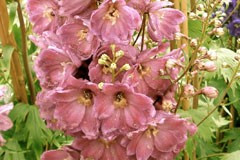
Gunnera manicata
Huge ornamental rhubarb from Brazil, suited to pond, bog, and streamside plantings. The leaves can be 1.5 - 2.5 m across, on stems up to 2.5 m in sheltered conditions.


Pink 'Pacific Giant' strain. Requires good soil and drainage to flourish. Delphiniums are best situated in an easterly aspect with morning sun only, protected from hot afternoon sun and drying wind.
Pink 'Pacific Giant' strain. Requires good soil and drainage to flourish. Delphiniums are best situated in an easterly aspect with morning sun only, protected from hot afternoon sun and drying wind.
Data sheet
Huge ornamental rhubarb from Brazil, suited to pond, bog, and streamside plantings. The leaves can be 1.5 - 2.5 m across, on stems up to 2.5 m in sheltered conditions.
We have grown seedlings of Alice Haysom, from which we have selected the best plants and increased from division. Best in well drained conditions in a pot or the rock garden.
Fantastic perennial unlike anything else. Large yellow sombrero-shaped daisies on 1.8 metre stems with large blue grey leaves. Focal point for the back of a mixed border or a feature in a prairie garden.
Old fashioned perennial flowering in summer, with cobalt blue spikes and ground covering habit. Easy amongst geraniums, Dianthus, and helianthemums.
Low growing mounding variety with finely dissected silver foliage for perennial border or amongst roses. Herbaceous habit makes it compatible with bulbs and other low growing perennials.
Tasmanian native flag iris, useful in combination with grasses and perennials. Lovely and abundant white flowers in spring, evergreen leaves and drought hardy.
I spotted this dwarf poker in the UK years ago, where I was struck by its compact form and abundant hot-orange pokers. It is winter dormant and makes a good grassy mound of leaves when not in flower.
A medium salvia for full sun positions with an interesting purple calyx surrounding the blue flower. Fine leafed foliage.
Useful spreading low growing variety with a long flowering period, suits cottage garden or perennial border.
Sky blue hydrangea, lighter in bud. In neutral or alkaline soil it tends to be light pink. Note all blue hydrangea need acid soil to produce correct colouring; in alkaline soil they will tend toward pink.
A compact low growing variety for foreground plantings, only just over knee high and easier to manage than some of the larger kniphofia. Colourful lemon yellow flowers in summer look good with rudbeckia, grasses and sedums.
Tall spiky plant with silver spherical heads. Great for flower arrangements and texture in the summer border. Best with morning sun only and enough water during summer.
Red form of Pulsatilla vulgaris, requires good drainage like other varieties, best for rock garden.
The best dwarf "English" hedging lavender, which only grows to 60 cm or so. Trim after flowering to encourage bushy plants. Long-lived and not messy like other varieties.
One our favourite new grasses, waist high flowers with rich green foliage, creating good mounding fill and texture within summer perennial plantings. Grows best on heavier fertile soils, and responds well to moisture in summer if available, but not overly demanding.

Pink 'Pacific Giant' strain. Requires good soil and drainage to flourish. Delphiniums are best situated in an easterly aspect with morning sun only, protected from hot afternoon sun and drying wind.